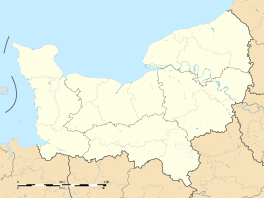Hermanville-sur-Mer
| Hermanville-sur-Mer | ||
|---|---|---|
| Commune | ||

WW II British cemetery
|
||
|
||
| Coordinates: 49°17′02″N 0°18′50″W / 49.284°N 0.3138°WCoordinates: 49°17′02″N 0°18′50″W / 49.284°N 0.3138°W | ||
| Country | France | |
| Region | Normandy | |
| Department | Calvados | |
| Arrondissement | Caen | |
| Canton | Ouistreham | |
| Intercommunality | CU Caen la Mer | |
| Government | ||
| • Mayor (2008–2014) | Jacques Lelandais | |
| Area1 | 8.05 km2 (3.11 sq mi) | |
| Population (2008)2 | 2,708 | |
| • Density | 340/km2 (870/sq mi) | |
| Time zone | CET (UTC+1) | |
| • Summer (DST) | CEST (UTC+2) | |
| INSEE/Postal code | 14325 /14880 | |
| Elevation | 3–59 m (9.8–193.6 ft) (avg. 25 m or 82 ft) |
|
|
1 French Land Register data, which excludes lakes, ponds, glaciers > 1 km² (0.386 sq mi or 247 acres) and river estuaries. 2Population without double counting: residents of multiple communes (e.g., students and military personnel) only counted once. |
||
1 French Land Register data, which excludes lakes, ponds, glaciers > 1 km² (0.386 sq mi or 247 acres) and river estuaries.
Hermanville-sur-Mer is a commune in the Calvados department in the Normandy region in northwestern France.
The beach of Hermanville, part of the area codenamed Sword, was one of the targets of Operation Overlord on 6 June 1944. The Cod German stronghold was located on the coast. A Norwegian destroyer, the HNoMS Svenner, sank in front of Hermanville.
The sector at Hermanville was known as Queen Beach where elements of the British 3rd Division landed. The South Lancashire Regiment landed on Queen White and East Yorkshire Regiment on Queen Red, by 10:00 the village had been cleared. Offshore from Hermanville a Gooseberry was established, this consisted of a breakwater formed with ships sunk into position, including the French battleship Courbet.
Hermanville is twinned with:
Hermanville-sur-Mer was the birthplace of:
...
Wikipedia



